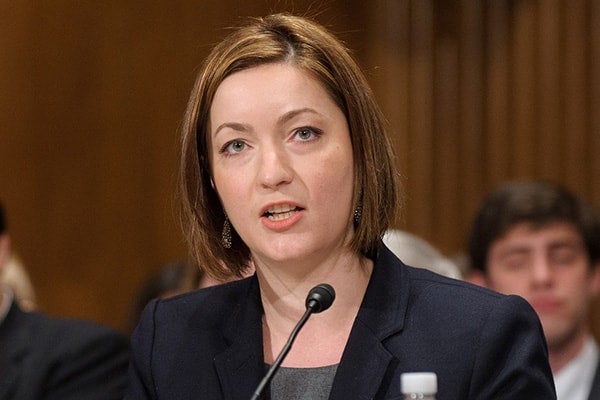
Dr. Martin goes to Washington
Published: March 20, 2014
Aided by a quick wit, a cool head and a careful command of the facts, Dr. Danielle Martin offered a spirited defense of the Canadian healthcare system before the United States Senate Subcommittee on Primary Health and Aging. Her testimony on March 11 has garnered coverage across North America and a video of her verbal sparring with Republican Senator Richard Burr of North Carolina has more than 630,000 views on YouTube. Martin, an Assistant Professor in the Department of Family and Community Medicine and Vice-President Medical Affairs & Health System Solutions at Women’s College Hospital, spoke with writer Liam Mitchell about the differences between the Canadian and American healthcare systems and what it was like testifying before the Senate subcommittee.
Canada has often been a reference point in the United States for what is good and bad about universal healthcare. Is our healthcare system fairly represented in this debate?
In any national debate about healthcare reform we tend to use other systems as shorthand for some particular issue that helps us make a point. For that reason, our system is often used as a stand-in for larger disagreements in the American debate. These characterizations are not generally “fair” — the Canadian system is used as a foil to reinforce preconceived notions about “socialized medicine” versus the free market.
American media coverage of health care in Canada perpetuates some inaccuracies about how our system actually functions.
For example, many Americans believe that ours is a fully “government run” or “socialized” system. The distinction is not drawn between the financing of care and the delivery of care. During my testimony in Washington, I spent some time explaining that our hospitals are mostly independent not-for-profit entities and our physicians are independent contractors, not employees of the state.
Another surprising American misconception about the Canadian system actually concerns its popularity. Anecdotes about Canadians fleeing south for care create the impression that we are unhappy with our system, when in fact poll after poll finds widespread pride and satisfaction with Canadian health care. Americans are also often surprised to learn how much pride we take in the shared Canadian value of equity and the principle that access to care should be based on need rather than ability to pay.
Our two countries share many similar health care system challenges that we find in all developed nations, including rising costs, variations in quality, and inequality of access. There is much that we can share with each other in terms of strategies to combat these challenges. I would love to see more opportunities to cut through the noise and actually discuss them.
A lot of the discussion seems to focus on waiting lines in the Canadian system. You said during your testimony, “sometimes it’s not about the amount of resources you have, but rather about how you organize people in order to use your queues most effectively.” Are we organizing our people to ensure the greatest impact?
Canadian governments, organizations and health care providers have worked hard over the past decade to reduce wait times for elective procedures. Here in Ontario, the Ministry of Health and Long-Term Care developed a well-known Wait Times Strategy that includes a centralized intake process for some procedures. Instead of physicians referring patients one at a time to individual specialists whose waits may vary widely, patients are referred to a central “hub” and are given the option to see the next available specialist. Think of the way you wait in a queue at the bank, with one single line dispersing to the next available teller – it’s the same concept. Or as I pointed out to the Senate committee, the building where we met that day had two entrances on opposite ends of the lobby. One entrance had a half-hour lineup at the security checkpoint while the other had none. Better organization of existing resources would have reduced the wait time to get inside.
There is more work to be done here in Ontario to organize our system, to make it more patient-centred and efficient. Much of that work can be done with the resources already in the system, and all within the single-payer structure of our health care system so that equity can be preserved and enhanced.
What lessons can we offer to our American neighbours on creating an effective and equitable healthcare system?
I think one of the most salient lessons we can offer relates to the process by which Canadian Medicare came to be adopted nationwide. Americans are often unaware that health care in Canada is administered provincially and that the origins of our current system lie in Saskatchewan rather than Ottawa. A nation that takes deep pride in its regional variation and which privileges the role of its states may find that instructive.
But truly, Americans need not only look north to find the example of an effective, equitable and deeply popular single-payer health system. American Medicare – that is, single payer health care coverage for all Americans over the age of 65 – is a “third rail” in American politics which politicians touch at their peril. In fact it was implemented more than a generation ago in 1965, only a few years after Saskatchewan extended public insurance to cover all physician services. Senator Sanders, who invited me to speak at his subcommittee hearing, is well aware of this history. As an American advocate for single payer health care, he is arguing for nothing more radical than simply extending this popular seniors health program to the rest of his country. The lesson of Canada for Americans is that such an extension is not only possible but has been functioning here in Canada for well over a generation.
Are there lessons we can draw from the American system?
Despite the differences between our systems, the challenges we face can be quite similar – and there is lots of innovation taking place in the US in thinking about how to address them. One example I have been engaged with recently is the notion of the Triple Aim approach to improving quality in health care. The concept of the Triple Aim was coined by Don Berwick of the Institute for Healthcare Improvement in 2008. The Triple Aim evaluates quality improvement initiative based on three dimensions: improving population health, improving the patient’s experience of care, and reducing per capita health care costs. The idea is that absent any of these dimensions of health the innovation is unsustainable or untenable. It’s a terrific model for approaching quality improvement and one that applies outside the US across all kinds of health systems. This year Women’s College Hospital is part of the first-ever Canadian cohort of health organizations that are incorporating this framework into our quality improvement efforts at our hospital and beyond.
After your testimony, you tweeted that the Canadian House of Commons looks tame after getting a taste of US Senate politics. What was it like to testify before the US Senate Subcommittee on Primary Health and Aging?
Well it wasn’t anything like House of Cards, and I say that with great relief! But it was definitely exciting.
The committee hearing was held in a Senate office building directly across the street from the U.S. Capitol dome. Washington, D.C. is a beautiful city and it was an honour to represent Women’s College Hospital, Toronto and our country in such an iconic setting. It was especially wonderful to be included as a panel member among international experts whose work I have admired enormously. I sometimes lecture on comparative international health systems, so to be on a panel alongside people from Taiwan, Denmark and France was inspiring.
I knew that the discussion would be heated given the context of health care reform underway in the US right now, so I wasn’t surprised that some of the Senators chose to challenge me. I doubt I changed anyone’s mind, but I was glad to have the chance to present both the evidence about outcomes in Canadian health care and the values that underpin it.
Liam Mitchell is a writer with the Faculty of Medicine at the University of Toronto.



